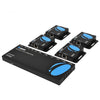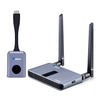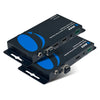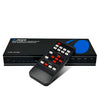
The entertainment industry is constantly evolving, and with it, the technology that supports it. As more and more people seek to enhance their audio and video experiences, new technologies are being introduced to the market. Some of the more recent ones are the HDMI 2.1 and eARC.
If you’re someone who enjoys high-quality audio and video for your home, work, or gaming setup, then understanding the difference between HDMI 2.1 and eARC is crucial. In this article, we’ll explore what HDMI 2.1 and eARC are, how they differ, and what advantages each technology offers.
So, is eARC the same as HDMI 2.1? Let’s start by defining both individually.
What is HDMI 2.1?
HDMI 2.1 is the latest version of a cable that connects devices such as TVs, gaming consoles, computers, and other multimedia devices. Its newer technology allows for the possibility of handling higher-quality videos and images than its predecessors. This means that it can display a resolution as high as 8K, while HDMI 2.0 can only display up to 4K resolution. HDMI 2.1 can also connect to devices specifically designed for gaming, which can make the overall gaming experience smoother.
Another great thing about HDMI 2.1 is its power to handle high-quality sound as well. This is where the eARC technology falls into place. eARC is a feature that is supported by HDMI 2.1 which allows you to transfer sound from your TV to a soundbar or other audio systems using a single cable.
What is eARC?
eARC, or Enhanced Audio Return Channel, is an upgraded version of the ARC technology. As mentioned earlier, eARC allows for sending high-quality audio from your display to your sound system. The main advantage of eARC over ARC is that it can handle better sound quality and it can synchronize sounds and pictures more accurately. eARC also has the power to support larger audio formats such as Dolby Atmos and DTS:X.
With eARC, you can enjoy high-quality sound from your TV without having to buy a separate sound system or run a bunch of cables between your devices.
HDMI 2.1 vs eARC: What are their differences?
Now that you have an idea of what HDMI 2.1 and eARC are, let's take note of the differences between each technology's capabilities.
First of all, HDMI 2.1 was created largely to meet the growing demand for more bandwidth in video transmission. The reason for this is so that material may be displayed on current screens without any lag or interruption, notably 4K and 8K TVs, which demand a large amount of bandwidth.
HDMI 2.1 also supports advanced video capabilities including VRR (Variable Refresh Rate), QFT (Quick Frame Transport), and ALLM (Auto Low Latency Mode). These features are especially useful for gamers. For example, upon starting a game, ALLM can automatically switch your TV to a low-latency mode, while VRR and QFT help with decreasing input lag and stuttering.
On the other hand, eARC is created to meet the growing need for more bandwidth in audio transmission. This is due to the fact that more immersive audio experiences are only possible with audio formats like Dolby Atmos and DTS, which demand a larger bandwidth.
Another key difference between HDMI 2.1 and eARC is their device compatibility. HDMI 2.1 allows for more versatility because it can be easily used with a wide range of devices, including gaming consoles, streaming devices, and TVs. The main reason behind this is that HDMI 2.1, on its own, can support both audio and video transmission.
For eARC, it is only used for audio systems. The eARC technology is designed mainly to support uncompressed and lossless audio formats. With this feature, eARC is only usually used in high-end audio setups, such as home theaters and entertainment rooms.
Lastly, it's also important to highlight that HDMI 2.1 is backwards compatible with all older HDMI devices. In simpler terms, HDMI 2.1 can be used for all types of HDMI devices, whether old or new.
eARC, however, is only backwards compatible with devices that support the original ARC feature. This means that if you own an older sound system, it's most likely that you can't use it directly for eARC. Although, you should also know that there are HDMI converters available that may allow you to use older sound systems with this newer technology.
Why is it important for you to know the basic eARC and HDMI 2.1 differences?
Understanding the distinctions between HDMI 2.1 and eARC enables you to make an informed decision once you decide to create your own audio and video setup. By knowing the capabilities and limitations of each technology, you can move one step closer to choosing the right devices that will suit both your needs and preferences.
For example, if you're planning to build a gaming setup that can support the latest action-packed games with high-quality graphics and sound, then you know that you should invest in a gaming monitor or TV that supports HDMI 2.1. Also, if you're one who loves to hear every detail of the game, you'll know that you should also invest in an audio system that supports eARC.
Also, by comprehending the difference between HDMI 2.1 and eARC, you can solve problems better when configuring your audio or video equipment. For instance, understanding the distinction between HDMI 2.1 and eARC might help you pinpoint the problem and find a fix if you are having audio issues when connecting your TV to your audio system.
When should you use HDMI 2.1 or eARC?
Since we’re almost done shedding light on the difference between HDMI 2.1 and eARC, as well as why it’s important to know them, let’s move on to understanding when and where you should use them.
If you are someone who values a seamless gaming and movie experience with advanced features like 8K resolution and HDR, then using an HDMI 2.1 cable plays a vital role in your setup. As mentioned earlier, HDMI 2.1 has a higher bandwidth as compared to its predecessors. The HDMI 2.1 has the power to support the most advanced features that will allow you to have a more smooth and more immersive experience.
Meanwhile, for audiophiles who want to relax peacefully in their room while listening to high-quality audio without any sort of compression or distortion, or for those wanting to hear every footstep in an action-packed film and simply listen as everyone walks past them, then eARC is the way to go. Experience a different level of immersion when you hear the amazing and crisp surround sound quality of eARC. With eARC, listening to audio files with advanced audio formats is as easy as A-B-C.
Ultimately, the choice between HDMI 2.1 and eARC highly depends on how you envision your audio and video setup. Ask yourself the right questions before purchasing everything you need. Do you have an 8K TV? Do you want to showcase advanced video features in your setup? Do you want to listen to high-quality uncompressed audio? Consider everything you want before building your home entertainment system so you can properly choose the technology that will help you achieve them.
It's also important to note that while all eARC devices are HDMI 2.1 compatible, not all HDMI 2.1 devices support eARC. This means that if you want to enjoy the benefits of eARC, you need to make sure that both your audio device and TV support eARC.
To conclude our discussion, we can establish that while HDMI 2.1 and eARC are both designed to provide higher bandwidth for video and audio transmission, both technologies still have their own unique features and benefits. HDMI 2.1 is ideal for gamers and movie buffs who love to utilize advanced display features like 4K resolution at 120Hz and HDR. On the other hand, eARC is perfect for people who have a good ear for hearing more crisp and clear sounds, and for those who have a knack for sound systems that support a higher level of surround sound feature.
Do you want to learn more about other types of HDMI technologies? Feel free to browse through our blog to check out more good reads and know which types of HDMI devices you might need for all of your future home and commercial setups!






















Comments
My Rotel preamp processor does not support Dolby Atmos , my Panasonic plasma has HDMI, what do I need to achieve Dolby Atmos listening with my sound system. Thank you.